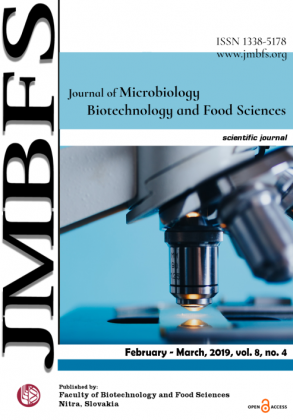THE EFFECT OF INCREASING DOSES OF FOLIAR APPLIED REGULATORS OF POLYAMINE BIOSYNTHESIS IN MIXTURE WITH TRIAZINE HERBICIDE ON FORMATION OF SPRING BARLEY BIOMASS
DOI:
https://doi.org/10.15414/jmbfs.2019.8.4.995-998Keywords:
triazine herbicide, cynazine, polyamines, GABA, DAPAbstract
The use of herbicides has become a potential tool in modern agriculture to get rid of weeds menace, but unknowingly the indiscriminate application of herbicides has resulted in adverse effects on the morphological, physiological and biochemical characteristics of crop plants. Herbicide effect of triazine herbicide (solo applied, or in combinations with regulators of polyamine biosynthesis: γ-aminobutyric acid, propylenediamine and salicyl acid) and quantitative parameters of spring barley (variety Kompakt) was evaluated under simulative conditions of hydroponic experiments under light platform. The experiment was carried out in hydroponics under light platform with linear fluorescent lamp at Department of chemistry SUA Nitra, where 9 pots was used with 24 barley grains/per pot of variety Kompakt and 5.5 litres of mineral solution, which were prepared from stock solutions containing optimal content of macro-elements (K, P, N, Ca, Mg) and micro-elements (B, Mn, Cl, Zn, S, Cu, Mo, Fe) for plants. At hydroponic experiment short-time negative effect of triazine herbicide at formation of biomass and root system and more significant negative influence at the amount of formed fresh biomass and root system were observed. Our experiments after foliar treatment of barley plants with herbicide confirm minimal short-time negative effect of mentioned herbicide. It indicates lowering of the amount of retained water in roots. Regulators of polyamine biosynthesis in hydroponics reduced inhibitory effect of tested pesticide on formation of organic matter, while their influence was manifested on amount of produced fresh biomass and root matter than on amount of dry matter. The most suitable doses of 100 g.ha-1 degradation product putrescine - GABA (γ-amino-butyric acid) and 59.2 g.ha-1 degradation product spermidine and spermine - DAP (1,3- propylendiamine) were used on elimination of negative effects of triazine herbicide in barley.Downloads
Download data is not yet available.
Downloads
Published
2019-02-01
How to Cite
Trebichalský, P., BajÄan, D., Harangozo, ĽuboÅ¡, Tóth, T., & StanoviÄ, R. (2019). THE EFFECT OF INCREASING DOSES OF FOLIAR APPLIED REGULATORS OF POLYAMINE BIOSYNTHESIS IN MIXTURE WITH TRIAZINE HERBICIDE ON FORMATION OF SPRING BARLEY BIOMASS. Journal of Microbiology, Biotechnology and Food Sciences, 8(4), 995–998. https://doi.org/10.15414/jmbfs.2019.8.4.995-998
Issue
Section
Food Sciences
License
Copyright (c) 2019 Pavol Trebichalský, Daniel BajÄan, ĽuboÅ¡ Harangozo, Tomáš Tóth, Radovan StanoviÄ

This work is licensed under a Creative Commons Attribution 4.0 International License.
All papers published in the Journal of Microbiology, Biotechnology and Food Sciences are published under a CC-BY licence (CC-BY 4.0). Published materials can be shared (copy and redistribute the material in any medium or format) and adapted (remix, transform, and build upon the material for any purpose, even commercially) with specifying the author(s).





